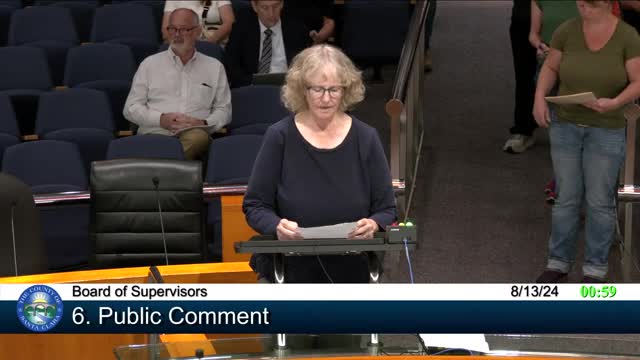Activist calls for ban on harmful plastic turf
August 13, 2024 | Santa Clara County, California
This article was created by AI summarizing key points discussed. AI makes mistakes, so for full details and context, please refer to the video of the full meeting. Please report any errors so we can fix them. Report an error »

During a recent government meeting, concerns surrounding the environmental impact of artificial turf were brought to the forefront by local resident Courtney Jansen, a parent of a youth soccer player. Jansen highlighted the significant drawbacks of plastic turf, including its high carbon footprint, potential health risks from chemical additives, and the extreme heat it generates, which can render fields unplayable during warm summer days.
Jansen presented data showing that on a clear day with temperatures reaching 89 degrees Fahrenheit, an artificial turf field in Sunnyvale soared to 150 degrees, posing risks of thermal burns and heat exhaustion for players. She argued that as climate change leads to more extreme heat, artificial turf fields will face increased closures compared to natural grass fields.
Furthermore, Jansen urged local supervisors to adhere to the California Environmental Quality Act (CEQA), which mandates environmental evaluations for projects to prevent significant harm. She pointed out that many California schools and cities have failed to comply with these regulations regarding plastic turf installations, risking legal challenges. An ongoing lawsuit against the city of Los Angeles over a plastic turf project exemplifies the growing scrutiny of such initiatives.
In contrast, a representative from Purchase Green Artificial Grass defended the use of artificial turf, emphasizing its benefits and the business opportunities it creates. This exchange reflects a broader debate on the sustainability of athletic facilities, with advocates for natural grass fields citing successful management practices in cities like Irvine, California, which has effectively maintained extensive natural grass athletic fields.
The meeting underscored the need for careful consideration of environmental impacts in local sports infrastructure decisions, as community members and business representatives continue to voice their differing perspectives on the future of athletic fields.
Jansen presented data showing that on a clear day with temperatures reaching 89 degrees Fahrenheit, an artificial turf field in Sunnyvale soared to 150 degrees, posing risks of thermal burns and heat exhaustion for players. She argued that as climate change leads to more extreme heat, artificial turf fields will face increased closures compared to natural grass fields.
Furthermore, Jansen urged local supervisors to adhere to the California Environmental Quality Act (CEQA), which mandates environmental evaluations for projects to prevent significant harm. She pointed out that many California schools and cities have failed to comply with these regulations regarding plastic turf installations, risking legal challenges. An ongoing lawsuit against the city of Los Angeles over a plastic turf project exemplifies the growing scrutiny of such initiatives.
In contrast, a representative from Purchase Green Artificial Grass defended the use of artificial turf, emphasizing its benefits and the business opportunities it creates. This exchange reflects a broader debate on the sustainability of athletic facilities, with advocates for natural grass fields citing successful management practices in cities like Irvine, California, which has effectively maintained extensive natural grass athletic fields.
The meeting underscored the need for careful consideration of environmental impacts in local sports infrastructure decisions, as community members and business representatives continue to voice their differing perspectives on the future of athletic fields.
View full meeting
This article is based on a recent meeting—watch the full video and explore the complete transcript for deeper insights into the discussion.
View full meeting
